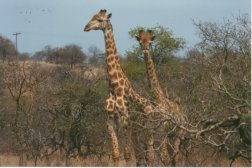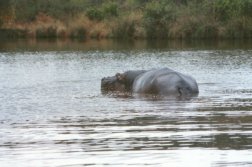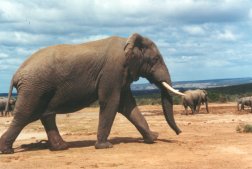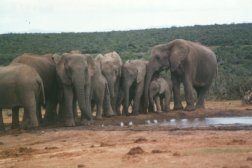September 1996
South Africa
<<<
Thursday, 5th September 1996
Awoken at 5.00 am by the ringing of the front doorbell, staggered downstairs to
find it is the taxi to take us to Heathrow Airport, only problem is the taxi is
not booked until 5.00 p.m. however as we had a lot to do before we set off for
South Africa, we put the extra time to good use. The plane took off at 10.00
p.m. and we had an uneventful flight, as the plane was only 50% full George was
able to spread out and get some sleep.
Friday, 6th September 1996
Doug & Ivy met us at Jo'burgh Airport and we were
quickly off to Rob and Jackie's new house on the outskirts of Joburg. Crime is
now such a problem in J'b that everyone locks their car doors when driving
through the city and most people have locks on the gates as well as their house
doors and windows, armed security firms are used by many homeowners.
Unemployment in SA is around 50% mainly in the black community, many of whom
seemed to be at many road junctions selling everything from fruit to car sun
shields; we kept our car windows closed and doors locked. Joburg was and still
is a mining town, the whole area has large resources of gold, platinum, diamonds
and coal. One diamond mine still produces two million Rand a day.
|
After refreshing ourselves we drove NNE for
about 2 hours to
Dikhololo (a place where people relax),
which is a conference and time-share holiday
centre in a small game reserve and has a small
selection of wildlife. We have an excellent
chalet which is a very large round thatched unit
built on a pile of rocks which extend inside so
forming an unusual centrepiece. The park is full
of exotic birds including grey louries, and
black-collared barbets and for neighbours, we
have a family of rock dassies which live in a
hole under the rocks.
|
|
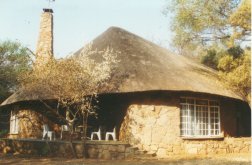
|
Saturday, 7th September 1996
We drove into Brit with Rob and Jackie who had arrived
the previous evening, to obtain provisions and fuel for the braai, on the way
back we stopped for refreshments at a delightful Inn which specialised in BBQ
meals.
Sunday, 8th September 1996
|
After Rob and Jackie left at 10.30 AM we drove
about 40 km to
Borakalalo
National Park, which is one of the
lesser known to tourists game parks but has a
good selection of the larger species. Initially,
we followed the track along the edge of the
Klipvoor Dam
where we saw numerous colourful birds including
hornbills, cormorants, herons, white egrets,
hammerlocks, coots, blue wax bills and a violet
crested roller. Further along the track, we saw
several leguaans (a 4-foot lizard), numerous
waterbuck, impala, kudu, water mongoose, and
several families of ostrich and giraffe.
|
|
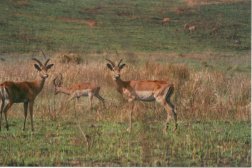
|
|
The Sefudi Dam
is no more than a water hole but even though it
was early afternoon we were delighted to watch a
family of warthogs come down for water and then
play in the mud, at the same time two terrapins
were getting amorous on a log at the edge of the
water hole.
|
|
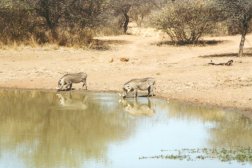
|
Monday, 9th September 1996
The Pilansberg National Game
Reserve lies NE of Johannesburg and mid-way to the
Botswana border. The park is in an eroded volcano that is more than
1,000 million years old and is one of the largest of its kind in the world,
being a natural sanctuary within rings of mountains. It is unique because it is
the result of one of the biggest ever game translocations since Noah's Ark. Over
6,000 animals have been relocated since 1979 The big five game animals, lion,
leopard, elephant, rhino and buffalo are within the park in good numbers but we
were not lucky to see any of them, however, we did see troops of baboons,
numerous giraffes, hippopotamus, zebra as well numerous species of buck To our
inexperienced minds it is fascinating to see that so many different species of
wildlife can coexist in the same area. It is the beginning of spring and the
middle of the dry period so the ground is very dry and many shrubs and trees are
bare or still shedding last year's leaves, yet at the same time blossom and
light green leaves have started to appear in many places which are close to a
water source.
|
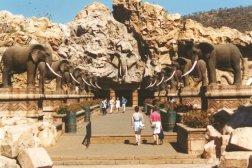
|
|
After adding numerous other species to our list
we went on to visit Sun
City and the Lost
City which are both parts of a very
large holiday-come casino complex just outside
the game reserve. It is a smaller version of Las
Vegas and considering it was built hundreds of
kilometres from civilisation in an area which
was previously just scrubland, it is very
impressive.
|
Tuesday, 10th September 1996
After going into Brit so Doug could arrange for the car aircon to be
repaired we had a lazy day at the Dikhololo game reserve, finishing the
day with a braai. Tried to connect to CompuServe but had no luck, is it my
equipment, the phone or the South African phone system? I plan to find out.
Wednesday, 11th September. 1996
Now had six days of unbroken blue skies, hardly any wind and temperatures which
do not drop below about 15C at night. Still getting accustomed to the sun being
in the north and how quickly it gets dark at around 7 pm
Pretoria
is the government capital of South Africa, and we drove there for half a day to
see some of the buildings and a few shops. However, after the quiet of Dikhololo,
we all agreed to leave Pretoria and find a quieter place for lunch.
After dark, we took a game night drive into the bush and saw many bucks and a
herd of zebra, most of the animals seem to be relaxed about tourists watching
them with a searchlight and just carried on eating.
Thursday, 12th September 1996
Doug left early to get the air con fixed on the car. Ivy and Valerie caught up
with the laundry and then packed a few things in preparation for leaving for
Swaziland. Spent the rest of the day relaxing and
then had a braai.
Friday, 13th September 1996
|
We left at 8.30 am for the fairly long drive to
the Mountain Inn hotel in
Mbabane, Swaziland. The first half of
the journey was not at all interesting, very
flat and polluted from the coal mines and steel
factories, however, the scenery improved as we
neared Swaziland where we had to enter the
Immigration building to have our passports
stamped. The Customs man asked to see in the
boot of the car but changed his mind about
searching when he saw the amount of luggage and
boxes on board.
|
|
Passed lots of Swazi mud and thatched huts and
roadside stalls selling avocados and other
exotic fruits, also carved items which Doug says
we will see plenty of tomorrow at the market.
The hotel is very nice with the rooms scattered
around the swimming pool - we have a lovely view
over the valley to the mountains.
|
|
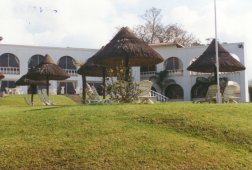
|
Swaziland
is a landlocked country, over 17,000 square kilometres in area and is the
smallest in the southern hemisphere. It is surrounded both on the north and
south by provinces of South Africa and on the east, it is bordered by
Mozambique. Mbabane is the administrative
capital where King Mswati III resides with his many wives.
Saturday, 14th September 1996
As it was Saturday we visited the local market which was selling local crafts
and fruit and vegetables at unbelievably low prices, the vegetable display was a
riot of every conceivable colour. Later we visited the Swazi museum, learning
much about the Swazi Nations' 150 years of history. We then had lunch at the
Matalanga game lodge overlooking the valley,
returning to laze around the hotel pool for the afternoon.
After some thought concluded that the Email connection problem may be due to us
using the wrong network setting, we changed to CSIR-Net and bingo, managed to
connect the first time. Like most things in life it is normally something simple
but finding out just what that little thing is out of the numerous possibilities
is the challenge.
Sunday, 15th September 1996
Woke to find the valley completely covered in low clouds so our intended game
drive was delayed until 10.30 when the sun came out. This was a very different
terrain to the previous reserves, hilly and some very rough roads. Rounded one
corner where we were confronted by two giraffes, which posed very well for the
cameras. Had lunch in the reserve at a restaurant that overlooked the hippo's
pool where there were three of the animals in situ. Whilst three of us were
happy with toasted sandwiches George of course had to try the Impala stew and
phuto (a local food which resembles porridge!)
Monday, 16th September 1996
It was time to leave Mbabane and travel to Pongola
which is just over the southern Swaziland border. The drive took about five
hours and along the route were numerous traditional round thatched mud huts
which are still lived in. Many are surrounded by stockades made from tree
branches to keep out wildlife and to occasionally pen in the cattle. These
villages do not have any water so the women collect water from the river which
can be some miles away, carrying it home on their heads. Most of the women still
wear traditional dress and it was a sobering thought watching them do their
washing in the river. Cattle, goats and donkeys roam all over the countryside
and use the roads extensively as they move from place to place. Swaziland is
still a very poor country by our standards but is comparatively well off
compared to many parts of Africa.
We are staying at the Leeukop private nature
reserve and the young man who is the Manager surprised us when he said he had
spent several years working in pubs in the UK and had worked in the Town Crier
at Hastings and lodged in Bexhill. It is a small world.
Tuesday, 17th September 1996
|
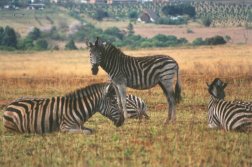
|
|
Up at 6.00 am for a boat cruise in anticipation
of seeing game and birds before the heat of the
day sent them seeking the shade. We saw
burchell's zebra and several species of buck as
well as several very large crocodiles, however,
did not see any sign of the python that lives
along the water's edge. Some of the more
interesting birds were the green-backed heron
and the snake-eating secretary bird which makes
its nest literally on the top of an acacia tree.
|
|
A beautiful gymnogene was catching lizards by
inserting its legs into holes in trees and
several African fish eagles were calling their
call, which is known as the call of Africa. This
is the windy time of the year but it is a very
pleasant warm wind, however it fans the local
scrub fires which are deliberately lit to
encourage the growth of new grass.
|
Wednesday, 18th September 1996
Still being surprised by the low cost of living in South Africa, typically
things are about 30% lower than in the UK. Beer is about R5 and our lodge
accommodation, breakfast and excellent four-course evening meal costs R150 a day
(£ is R7). Up early again for a five-hour game drive adding another eight birds
and three animals to our growing list and then it was back for a late brunch.
Later on, we went for a four-hour late afternoon and night game drive even
though it was very cold it was interesting to see creatures like the
white-tailed mongoose, baby jackals and the hardly ever seen small spotted
genet, which all being nocturnal are normally only seen at night. One
fascinating sight was seeing about two dozen mongooses following each other nose
to tail along a track and then heading off into the bush when they saw us. Our
list of birds has now grown to 49 and animals to 21.
Thursday, 19th September 1996
We shared the driving during our 600 km journey south staying at the Oribi Gorge
Hotel which in its day must have been a very grand place, but it has been poorly
maintained and we will be happy to move on tomorrow.
Friday, 20th September 1996
|
It was a long day’s drive (700 km) to Ivy and
Doug's home in Port
Elizabeth mainly along the N2 which
follows for the most part the eastern coast, so
we had our first view of the Indian ocean. The
road took us through
Transkei country which is mountainous
terrain of 400 km, on the slopes are numerous
Xhosa (President
Mandella's tribe) villages with their
traditional round thatched houses brightly
painted in the characteristic light green.
|
|
We saw women carrying up to three tree logs 6 Mt
long on their heads, George remarking that he
would not be able to even carry one on its own.
The centre of the village was crowded with the
locals milling all over the road where they were
buying fresh fruit and vegetables. The only
means of transport for most of the black
population is by walking long distances or using
one of the hundreds of non-timetable minibuses
which travel at very dangerous speeds.
|
|
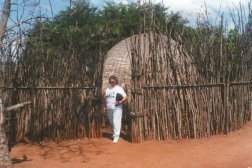
|
Saturday, 21st September 1996
Caught up on the washing and needed to stock up on food so the first stop was at
the local fruit store where they were selling large quantities of paw paw,
butternuts, gems, mangos, grenadilla and with prices like avocados and pineapple
at 4 for R5 (20p each) it is difficult not to buy too much.
Sunday, 22nd September 1996
Maitland
(east of P.E.) is one of many places where is possible to see whales in
St. Francis Bay close to the shore, within
a few minutes of arriving at the beach we were watching whales surfacing, diving
and blowing water out of their breathing holes, it is a magnificent sight. The
whales use the bay to give birth as well as being a good feeding ground. After a
pub lunch at the harbour, we saw numerous vintage Alfa Romeos at a beachside
rally.
Monday 23 September 1996
Doug loaned us the car for the day so we spent some time in the Green Acre
Shopping Mall mainly buying odds and ends, after which we did some local site
seeing. P.E. is heavily industrialised around a large part of the harbour area
but has magnificent long and mainly sandy beaches to the east. The southern
coast at this time of year is very windy but fortunately, it is a reasonably
warm wind and even in the middle of winter it never snows on the coast.
Tuesday 24 September 1996
Today is Heritage day and a national holiday, so like most of the locals, we
wandered along the promenade followed by a light bite at the Walmer Gardens
Hotel.
Wednesday 25 September 1996
What a fascinating day. We went to the vast
Addo Elephant National Park
which is about 75km from P.E. After driving through the park for about an hour
we had only seen one giant tortoise when we suddenly came across a small group
of elephants around a watering hole. While watching them we realised that there
were several other families of elephants in the bush waiting their turn to drink
at the water hole. For the next hour, we watched in awe as the elephant families
came in turn to the water hole led by their matriarch. The family members ranged
in size and age from babies less than one year to huge males which were
constantly watching out for any danger, to the extent that one huge male
deliberately walked right up to the front of our car, stopped, waved his trunk
at us, stared into our car and then slowly walked around us. At one point about
80 elephants were grouped around us, some drinking, some playing and a few
sparring with each other and on occasions males from different families
threatened each other.
Nearly forgot to mention the sign at the entrance to the park states one should
not run over dung beetles. They are surprisingly large spending most of their
lives moulding dung into balls and then roll it along the ground for up to
80mts. for the female to lay her eggs in - nature sure has developed some
strange creatures. After lunch, we came across buffalo taking a rest in the
shade of some trees, and numerous ostrich as well hartebeest grazing in the open
plains.
Thursday, 26 - Sunday, 29 September 1996
This week was a time to relax, catch up on the chores and have a look around
P.E. Having not been to the cinema for over a year we made two visits this week.
We will be able to sleep easily knowing that the USA has saved the world from
destruction by space invaders by planting a computer virus in their mothership -
in other words, one of the films we saw was Independence Day!
Monday, 30 September 1996
The plan for the next three weeks is first to tour the Garden Route, then the
Wine Route and finally spend about one week in Cape Town
before returning to the UK. We drove about 300 km to Wilderness which is a small
village near the town of George where we will stay at the Fairy Knowe Hotel for
three days, using it as a base to tour the Garden Route area. On the way, we
stopped for a short while at Jeffreys Bay
which was founded by a shipwrecked sailor. Today it is a very attractive and
desirable place to live but mainly by the whites contrasting strongly with
Humansdorp some 20 km to the west which is a
much poorer township mainly for the black community.
>>>
Home





